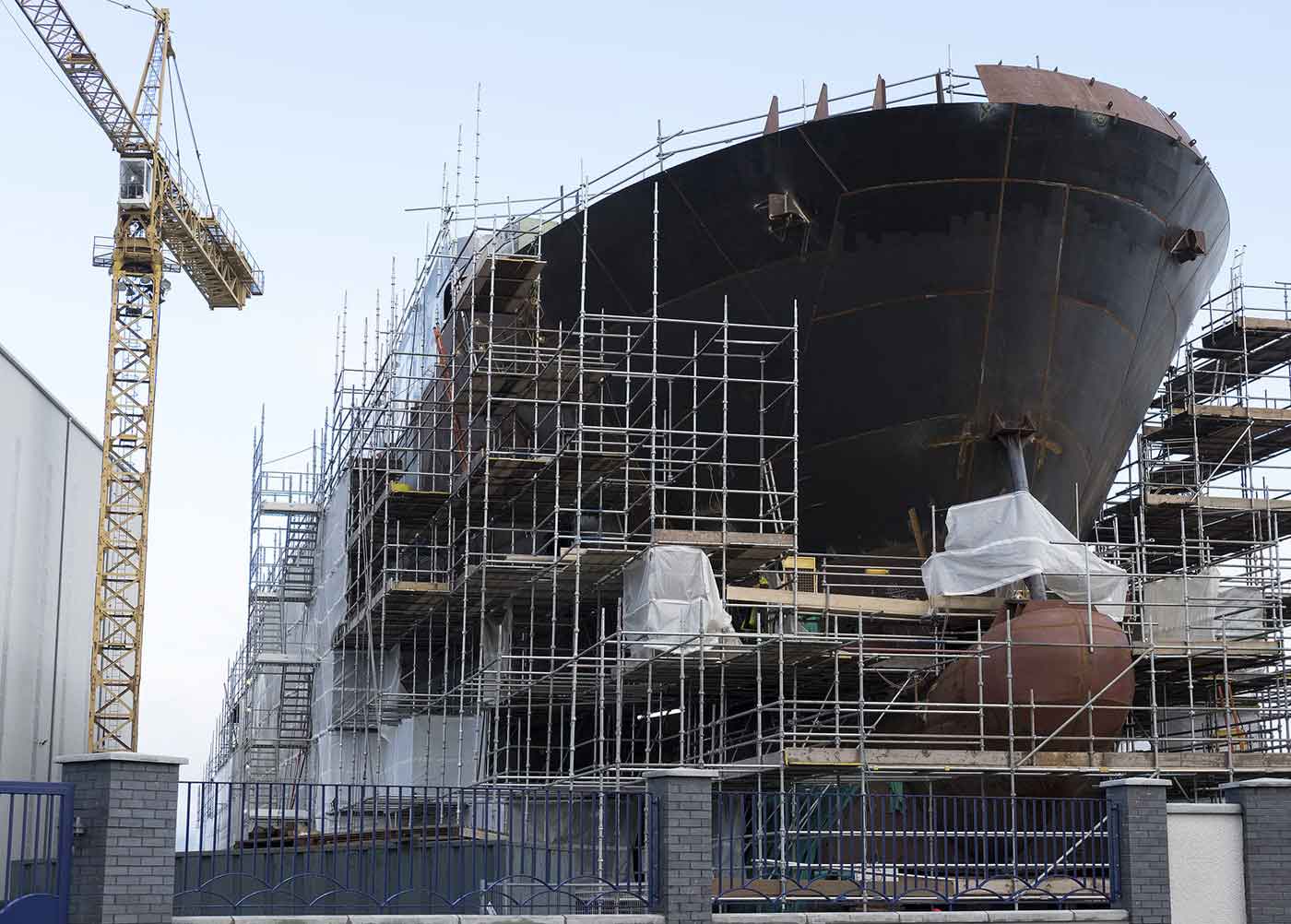01. Shipyard History
History
The Portsmouth Naval Shipyard opened in 1800 and continues to operate today. It is physically located in Kittery, Maine, on Seavey Island across the harbor from Portsmouth, New Hampshire.
In 1815 it launched its first ship, the 74-gun warship USS Washington. During WWI, the shipyard took on the task of constructing submarines as well as the overhaul and repair of surface vessels. With more than 25,000 employees during WWII, the shipyard constructed over 70 submarines.
The construction of submarines continued at the Portsmouth Naval Shipyard until 1969 when the last submarine built in the shipyard, the nuclear-powered USS Sand Lance, was launched.
Still in service to the Navy today, the shipyard supplies the United States submarine fleet with overhaul, refueling and modernization work.
Portsmouth Naval Shipyard History at a Glance
- Other Names: PNSY, PNS
- Location: The Portsmouth Naval Shipyard is physically located in Kittery, Maine, specifically on Seavey Island which sits at the mouth of the Piscataqua River. This federally-owned island is across the harbor from Portsmouth, New Hampshire, with access to the mainland by two bridges that connect to Kittery, Maine.
- Owner(s): Federal Government
- Years of Operation: 1800 – Present
- Wartime Operations: WWI and WWII
- Number of Employees: More than 25,000 during World War II
- Size of Shipyard: 297 acres
- Noteworthy Ships: USS Washington, USS Albacore, USS Constitution, USS L-8, USS Snapper, USS Balao, USS Odax, USS Irex, USS Swordfish, USS Abraham Lincoln, USS Dolphin, USS Squalus/Sailfish
- Types of Ships Built/Serviced: Submarines, warships
Many workers at Portsmouth Naval Shipyard were potentially exposed to asbestos. Workers’ loved ones may have also experienced secondhand exposure. As a result, many people developed asbestos-related diseases, such as asbestosis, asbestos lung cancer, and pleural and peritoneal mesothelioma. People who developed an asbestos-related disease may be eligible for compensation.
Notable Ships Built and Repaired
As an active shipyard for more than 200 years, workers in the Portsmouth Naval Shipyard have constructed, repaired, modernized and overhauled an unprecedented number of submarines. These submarines served in several capacities all over the world and continue to serve today.
Asbestos was used in submarine building for decades at the Portsmouth Naval Shipyard. As a result, many workers were put at risk for developing asbestos-related diseases.
USS Balao (SS-285, later AGSS-285)
The lead ship of her class, USS Balao was commissioned on February 4, 1943, at Portsmouth Naval Shipyard, during a time when asbestos use was at its height in the production of materials used on ships and submarines. This practice put crew members and workers at high-risk of developing asbestos-related diseases such as mesothelioma.
Deployed to the Pacific, she was based out of Australia and Pearl Harbor where she patrolled for enemy ships and rescued downed aviators. Following an overhaul in California in December 1944, Balao returned to the Pacific and served until Japan’s surrender. Decommissioned in August 1946 and recommissioned in March 1952, Balao became a training ship in both Key West, Florida, and Guantanamo Bay, Cuba.
In 1959, she starred as the “pink submarine” in the motion picture Operation Petticoat. During the Cuban Missile Crisis in October and November 1962, she was sent to patrol the western Atlantic. Decommissioned on July 11, 1963, her hulk was sunk off northern Florida on September 6.
USS Albacore
The USS Albacore was designed, built and maintained at the Portsmouth Naval Shipyard and she served as a sea-going test platform from 1953 to 1972. This was at a time when asbestos was used heavily in the production of boilers, insulation and pipe coverings. This asbestos use put workers and crew members at risk of asbestos-related diseases such as mesothelioma.
The submarine was the first Navy-designed vessel with a true underwater hull of cylindrical shape. Albacore’s teardrop-shaped hull was the prototype for the Navy’s nuclear-powered submarine force and was the first boat built specifically to operate underwater. In 1966, she set the record as the world’s fastest submarine having attained an underwater speed of nearly 40 miles per hour.
She was used for testing control and propulsion systems, sonar equipment, dive brakes, escape mechanisms and various innovative theories and equipment. In September of 1972, Albacore was decommissioned and placed in reserve at the Inactive Ship Facility in Philadelphia. She is now on permanent display at Albacore Park in Portsmouth.
02. Shipyard Asbestos Use
Asbestos Use at Portsmouth Naval Shipyard
Because asbestos is heat resistant and durable, it was commonly used in ship construction. Raw asbestos and various asbestos products were used throughout ships to help prevent fires. Use of the mineral also helped control heat emitted by machinery, such as boilers and engines.
Portsmouth Naval Shipyard was an active worksite beginning in 1800 and is still active today. Asbestos was commonly used on ships during large periods of this time. Workers at Portsmouth Naval Shipyard used asbestos as insulation in walls, around pipes, in boilers and elsewhere on ships. As a result, workers came in contact with many products that put them at risk of asbestos-related diseases.
Asbestos Exposure at Portsmouth Naval Shipyard
It was common for members of the U.S. military and civilians to provide labor in shipyards and on ships. Asbestos was used in most shipyards and aboard most Navy vessels from the 1930s to the 1980s. This likely exposure puts Navy veterans at an increased risk of mesothelioma.
People who constructed or maintained warships and submarines during this time were likely exposed to asbestos. These people often worked in space-constrained and poorly ventilated areas, which possibly allowed more asbestos fibers to remain in their workspaces. For example, enginemen and machinists faced asbestos exposure.
Asbestos is no longer used in most manufactured products. However, its historical presence in ships and navy vessels can put people at risk of exposure. People who repair or decommission ships built from the 1930s to the 1980s currently face asbestos exposure. Many shipyard responsibilities, such as installing insulation and pipes, led to frequent exposure.
03. Asbestos Lawsuits
Asbestos Lawsuits and Settlements
Shipyard workers, veterans and visitors of Portsmouth Naval Shipyard are at risk of developing mesothelioma or another asbestos illness. Those diagnosed have several asbestos claim options to receive financial compensation.
Asbestos-disease victims can seek compensation from the companies responsible for their exposure. An individual’s claim options will vary depending on each company’s current status. Victims can work with a mesothelioma lawyer to discuss their options and obtain compensation through a lawsuit, settlement, trust fund and/or VA claim (or a combination of these types of claims).
Holding Asbestos Companies Accountable
Various companies that used to manufacture asbestos products have not filed for bankruptcy. Individuals can file lawsuits against such companies. Asbestos lawsuits can provide victims compensation through verdicts or settlements.
For example, Warren Pumps, LLC is a viable company that wrongfully exposed workers at the Portsmouth Naval Shipyard to asbestos through the pumps they produced. These pumps were used within the machine shops. As a result of the asbestos exposure, lawsuits have been filed against the company.
A.W. Chesterton is another viable company that supplied asbestos materials to Portsmouth Naval Shipyard. The company used asbestos fibers in its industrial fluid sealing products. As a result, people were wrongfully exposed. Some victims have filed successful lawsuits against the company.
04. Filing Asbestos Claims
Asbestos Company Trusts
Some companies who wrongfully exposed people to asbestos turned to bankruptcy to handle asbestos-related claims. Since the 2000s, more than 100 companies have taken this approach. Many of these asbestos companies created trust funds in order to compensate victims of asbestos-related diseases.
Shipyard workers developed asbestos-related diseases after working with asbestos products. One compensation option for these individuals is to file a claim with that asbestos company’s trust.
Asbestos Company Trust Funds and Eligible Years of Employment
The following companies provided asbestos products to Portsmouth Naval Shipyard. After facing many asbestos lawsuits and exposing innocent people to asbestos, these companies filed for bankruptcy and created trusts to pay victims. If an individual worked at Portsmouth Naval Shipyard and developed a disease such as mesothelioma, they may be able to file a claim against these companies’ trusts.
| Asbestos Trust Funds & Eligible Years of Employment | ||
|---|---|---|
| Asbestos Company Name | Eligibility Start Date | Eligibility End Date |
| Babcock & Wilcox | 1/1/1908 | 12/31/1982 |
| Combustion Engineering | 1/1/1941 | 12/31/1982 |
| Fibreboard | 1/1/1940 | 12/31/1982 |
| Flexitallic | 1/1/1941 | 12/31/1982 |
| G-I Holdings (GAF) | 7/16/1959 | 3/23/1961 |
| Keene Corporation | 1/1/1951 | 12/31/1982 |
| Owens Corning | 1/1/1951 | 12/31/1982 |
| Pittsburgh Corning | 1/1/1969 | 12/31/1982 |
| United States Gypsum | 1/1/1956 | 12/31/1982 |
| Yarway | 12/26/1980 | 12/31/1982 |




